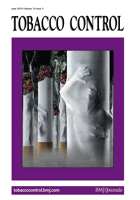Abstract:
Objective: Portrayal of tobacco use in films has been causally linked to youth smoking initiation. However, findings regarding trends in portrayal in U.S. films since 1950 are inconsistent, potentially due to differences in sampling densities, inter-coder reliabilities, and time periods covered. The present study was designed to overcome these inconsistencies with a common sampling frame and methodology.
Methods: A half sample of the 30 top grossing U.S. films per year from 1950 to 2006 (N = 855) was coded in 5-minute segments for total tobacco-related content and main character tobacco use. Film tobacco trends were identified using linear regression and compared to national per capita cigarette consumption and historically significant tobacco control events.
Results: Tobacco content declined considerably since 1950. Total tobacco-related content peaked around 1961, while the decline in portrayal of main character use was already underway in 1950. Cigarette consumption peaked around 1966 with a trend that closely paralleled total tobacco content and that coincided with major tobacco control events.
Conclusion: This study, which had high reliability, dense sampling, and covered a long time period, indicates that tobacco content has declined in top-ranked U.S. movies since 1950 with a trend in total tobacco content that closely paralleled the drop in per capita cigarette consumption and the increase in significant tobacco control efforts. Despite the inability to draw causal conclusions, tobacco portrayal in films may serve as barometer of societal support for the habit and thus efforts should continue to limit exposure to such content.


